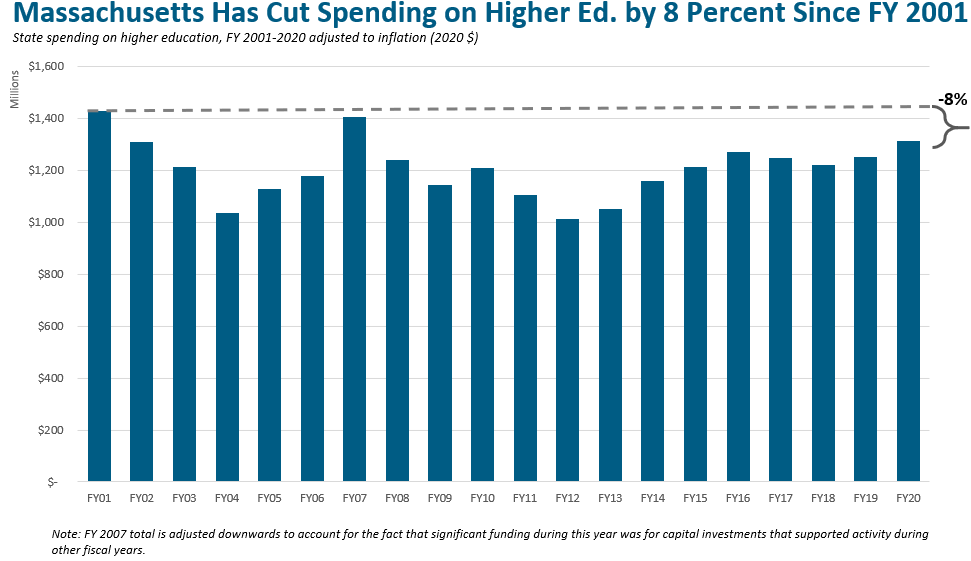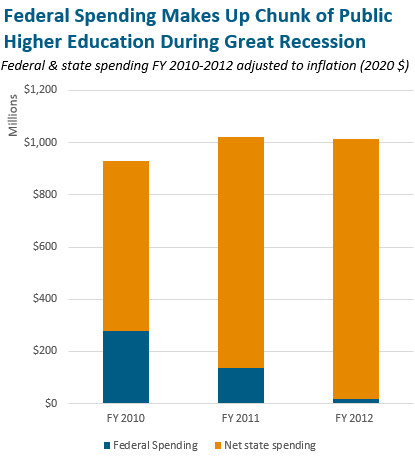A well-funded public higher education system has the power to open up countless opportunities for low-income students and families of all races and backgrounds. For many students and families of color, higher education is a necessary element in a journey toward upward economic mobility and stability. Those with completed post-secondary education are more likely to be healthier [1], earn twice as much as those with a high school diploma[2], and people with even some college education are less likely to be fired and more likely to be hired back during and after economic downturns.[3] Because of this, families place priority on their student’s higher education despite their own financial sacrifices.
The impact of deep budget cuts today could potentially be felt for years to come. Past recession-based budget cuts to public higher education have hurt campuses and have also translated to higher tuition and fees and an affordability crisis most deeply felt by students of color.
The Fiscal Year (FY) 2021 budget for public higher education in Massachusetts is already experiencing challenges. The impacts of COVID-19 and the economic downturn have caused budget cuts within our state’s public campuses that are likely to be deep and damaging to both students and staff. The Board of Trustees approved an FY 2021 budget for the University of Massachusetts (UMass) system which is about $171 million less than actual spending in FY 2020. To accommodate these financial adjustments, UMass has cut about 1,125 student and temporary jobs, laid off 134 workers, and will terminate another 397 positions. While UMass also announced an in-state student tuition freeze to protect students from even higher tuition rates, this freeze means UMass will forgo about $18.6 million in revenue.[4] At Springfield Technical Community College, seven academic programs have been cut along with 21 positions, including 11 faculty.[5] These bruised budgets may only be the beginning.
In June 2020, the Massachusetts Department of Higher Education released a report that community colleges face an estimated $27 million to $118 million loss in revenue next year and state universities face a loss of $74 million to $248 million. Estimates for the report were based on revenue losses from tuition and academic fees, state appropriations, residence life and housing (specifically for state universities), and other cost-saving recommendations.[6]
Investment for Recovery and More

Well-funded public universities and colleges — especially community colleges — provide a critical pipeline for training and re-training students for the jobs essential to the state’s economic recovery. States with a greater share of college-educated workers tend to have stronger, higher-wage economies. Furthermore, graduates of public institutions are more likely to live and work in Massachusetts after graduation, meaning they are more likely to contribute to our communities and economy in the long run.[7] A recent analysis has shown long-term investments in public higher education provide graduates with opportunities for both human capital (skill-building) and social capital (relationship building within a career). Moreover, college graduates are more likely to have larger social networks of friends and mentors that ultimately expand future opportunities, and they are more likely to have the advanced skills which secure jobs with higher salaries. Higher salaries in turn mean more dollars flowing through their communities which increases the tax revenue available to fund schools and other public programs.[8]
Recent Budgets and Rippling Effects
Despite the benefits, public higher education offers both students and our economy, funding for public higher education has not only been cut during the prior two recessions, but it has also been cut in some years since. In fact, funding for higher education has never been restored to its FY 2001 level of $1.4 billion (inflation-adjusted). In the latest FY 2020 budget, funding for higher education was $1.3 billion, 8 percent below funding in FY 2001 when adjusted for inflation (see the chart below).[9]

When state funding declines or is not sufficient to cover rising costs, public colleges and universities make up for their bruised budgets by increasing tuition and fees. Shifting the cost of higher education from the state budget onto students has contributed to a higher education affordability crisis which particularly hits low-income students and students of color.[10]
Between FY 2001 and FY 2019, average tuition and fees for public campuses per student increased by about $6,100 while state funding decreased by $2,790 (adjusted for inflation).[11] Ultimately, this has left students and their families with the burden of figuring out how to pay these increased costs. Between 2001 to 2016, Massachusetts had some of the highest public higher education tuition and fee increases in the nation.[12]
The increased costs of public higher education have created the steepest obstacles for Black and Latinx students. In 2017, the average, annual net price of a public four-year institution in Massachusetts (the price of tuition and fees, room and board, and books and supplies, minus the average aid received for a student) accounted for 38 percent of a Black family’s median household income and 43 percent of a Latinx family’s median household income. In comparison, this price is just 21 percent of a white family’s median household income.[13]
These burdens are also mostly felt by students of color and low-income students because they are more likely to attend public colleges and universities in Massachusetts. In the 2018–19 school year, 79 percent of Black high school graduates and 83 percent of Latinx high school graduates attended public colleges and universities in Massachusetts. Meanwhile, 70 percent of white graduates attend public campuses in Massachusetts.[14]
Many families look to scholarships to help make college affordable. However, Massachusetts has cut state scholarship funding by 29 percent since FY 2001 (adjusted for inflation).[15] The largest portion of state scholarship funding goes to MassGRANT which is a needs-based program for low-income students. Because of these cuts, there is less scholarship money available for low-income students.[16] Without sufficient scholarship money, many students turn to loans. This is especially true for Black and Latinx students who are most likely to take out loans and borrow greater amounts.[17] The share of graduates from public higher education with loan debt has increased from 54 percent in FY 2001 to 73 percent in FY 2018.[19] Additionally, the average debt of public higher education graduates in FY 2018 was around $32,000 in Massachusetts — an increase of 54 percent since FY 2001.[18]
Past Recession Budgets and Consequences

Over the past two decades, there have been two other recessions. From these, there are important budget lessons policymakers can look back on. During the 2001 recession, the state government cut close to $3 billion (in nominal dollars) from public services like education, local aid, and public health between 2001 and 2004. By 2004 higher education funding had been cut by $392.9 million adjusted for inflation.[19] State funding for public higher education was also cut during the Great Recession of FY 2009–2012, by $131.7 million.[20] During FY 2010–2012, to offset state funding shortages, policymakers had access to targeted federal funding from the American Recovery and Reinvestment Act (ARRA). During these years, the state relied on more than $430 million from the ARRA State Fiscal Stabilization Fund to fund public higher education.[21] This money allowed the state to avoid what would have been even deeper cuts to public higher education.
Crucial Next Steps
Investing in public higher education is an antiracist policy choice. Not only do accessible and affordable public campuses benefit the Commonwealth overall, but they also provide clear pathways to economic equity for Black and Latinx students.
The state’s next steps are crucial for the Commonwealth’s economic recovery and for work towards systemic change to ensure equity. If the federal government does not step in, as it did during the Great Recession with significant new revenues, policymakers will have to make a choice. They can either choose to raise the progressive revenue necessary for supporting critical programs such as higher education, or they will choose to cut essential services. Economic recovery from this current recession will require a well-educated workforce. Choosing to cut funding to public higher education could, once again, have long-lasting impacts on opportunities for students of color and on the prospects for a thriving Commonwealth.
- Updated September 11, 2020
- Anastasia Martinez is a Policy Analyst and State Policy Fellow focused on education research and analysis at MassBudget.
Want more information from MassBudget? Sign up to receive our newsletter and visit us at massbudget.org
ENDNOTES:
[1] Philip Oreopoulos, and Uros Petronijevic. “Making College Worth It: A Review of the Returns to Higher Education”. The National Bureau of Economic Research. May 2013. https://www.nber.org/papers/w19053
[2] Diane Whitmore Schanzenbach, Lauren Bauer, and Audrey Breitwieser. “Eight Economic Facts on Higher Education”. The Brookings Institute. April 2017. https://www.brookings.edu/wp-content/uploads/2017/04/thp_20170426_eight_economic_facts_higher_education.pdf
[3] Anthony P. Carnevale, Tamara Jayasundera, and Artem Gulish. “America’s Divided Recovery: College Haves and Have Nots”. Georgetown University Center on Education and the Workforce, McCourt School of Public Policy, 2016. https://cew.georgetown.edu/wp-content/uploads/Americas-Divided-Recovery-web.pdf
[4] Chris Lisinski. “UMass Pairs Tuition Freeze With Layoffs And Spending Cuts”. WBUR. July 2020. https://www.wbur.org/edify/2020/07/20/umass-cut-budget-freeze-tuition
[5] Laura Krantz and Deirdre Fernandes. “Budget cuts, layoffs, furloughs-COVID-19’s effect on colleges will shape higher ed for decades”. Boston Globe. July 2020. https://www.bostonglobe.com/2020/07/20/metro/colleges-universities-pandemic-forces-budget-cuts/
[6] Massachusetts Department of Higher Education. EY Parthenon Report. June 2020. https://www.mass.edu/bhe/lib/documents/2020-06-23%20EY-Parthenon%20Presentation.pdf
[7] Jeremy Thompson. “Educated and Encumbered”. MassBudget. March 1, 2018. https://massbudget.org/report_window.php?loc=Educated-and-Encumbered.html
[8] Michael Ash & Shouvik Chakraborty. “An Economic Analysis of Investment in Public Higher Education in Massachusetts: Recovering from the COVID-19 Crisis and Laying Foundations for the Future”. University of Massachusetts Amherst. June 2020. https://massteacher.org/-/media/massteacher/files/Reports/MTA_Economic_Report_Web
[9] MassBudget analysis of budget data. See also MassBudget Budget Brower http://browser.massbudget.org
[10] Michael Mitchell, Michael Leachman, & Matt Saenz. “State Higher Education Funding Cuts Have Pushed Costs to Students, Worsened Inequality”. Center on Budget and Policy Priorities. October 2019.
[11] MassBudget analysis of tuition and fees for years 2001–2020 and state funding to higher education for years 2001–2020. See MassBudget Budget Browser http://browser.massbudget.org. Tuition and fee data provided by Mass. Department of Higher Education https://www.mass.edu/datacenter/tuition/AppendixTuitionFeesWeight7.asp
[12] Jeremy Thompson. “Educated and Encumbered”. MassBudget. March 1, 2018. https://massbudget.org/report_window.php?loc=Educated-and-Encumbered.html
[13] Michael Mitchell, Michael Leachman, & Matt Saenz. “State Higher Education Funding Cuts Have Pushed Costs to Students, Worsened Inequality”. Center on Budget and Policy Priorities. October 2019.
[14] State profiles, Mass. Department of Elementary and Secondary Education
http://profiles.doe.mass.edu/statereport/gradsattendingcollege.aspx
[15] MassBudget analysis of budget data. See also MassBudget Budget Brower http://browser.massbudget.org
[16] Higher Education Finance Commission, Report to the General Court of Massachusetts, October 14, p.11. https://www.mass.edu/bhe/lib/documents/HigherEducationFinanceCommission-FinalReport10-2014.pdf
[17] Scott Fullwiler, Stephanie Kelton, Catherine Ruetschlin, and Marshall Steinbaum. “The Macroeconomic Effects of Student Debt Cancellation”. Levy Economics Institute of Bard College. February 2019. http://www.levyinstitute.org/pubs/rpr_2_6.pdf
[18] College Insight. Generated table of “Student Debt of Graduating Seniors”, variables: National Average Debt, National Percentage of Graduates Borrowing, Massachusetts Average Debt, and Massachusetts Percentage of Graduates Borrowing. Adjusted to inflation. https://college-insight.org/topics/student-debt-of-graduating-seniors/1
[19] MassBudget analysis of budget data. See also MassBudget Budget Brower http://browser.massbudget.org
[20] MassBudget analysis of budget data. See also MassBudget Budget Brower http://browser.massbudget.org
[21] MassBudget analysis of ARRA federal relief funds used in public higher education spending using actual spending totals rather than budget totals in order to align with the timing of actual revenue receipts. Data from https://www.macomptroller.org/cthru





